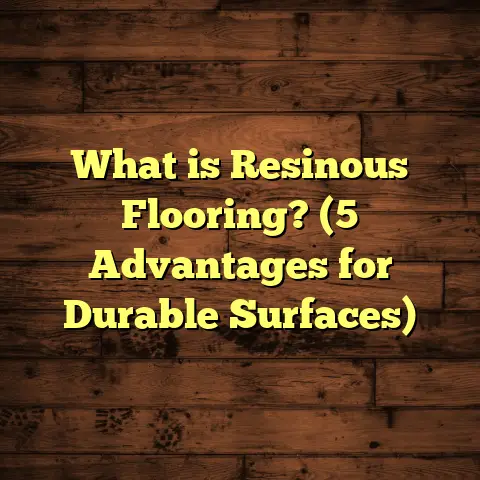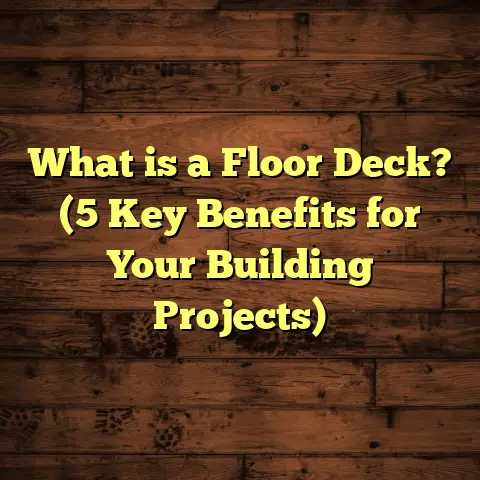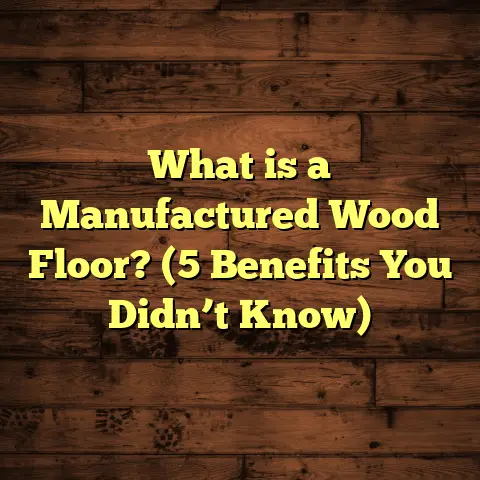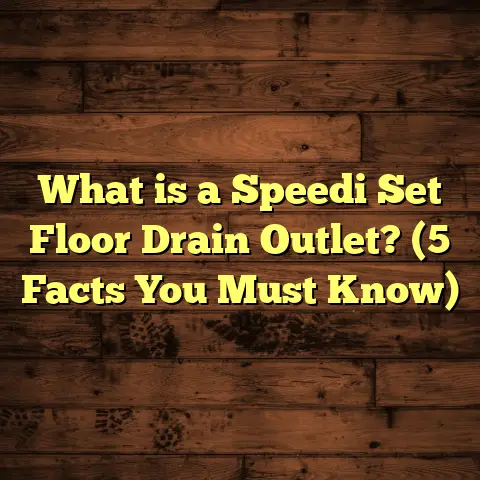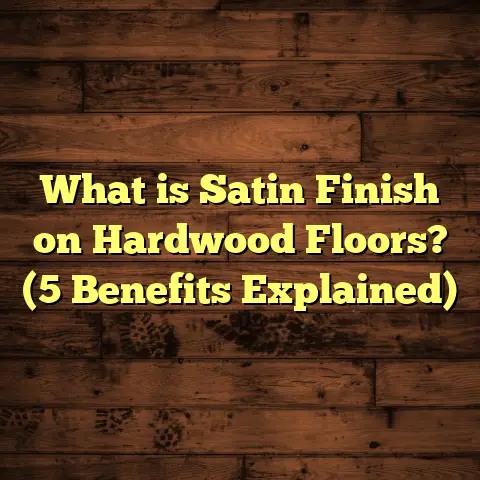What is IVP Flooring? (5 Essential Benefits for Homeowners)
Bold Designs and Flooring: Why IVP Flooring Is Catching My Eye
When I think about bold designs in home interiors, the floor often gets overlooked. But honestly, the flooring sets the tone for everything else. Over the years, I’ve worked with many types of floors, but one that has consistently caught my attention is IVP flooring. It’s got this sleek, modern vibe that pairs beautifully with daring design choices while offering practicality that suits everyday living.
So, what exactly is IVP flooring? Let me walk you through it.
What is IVP Flooring?
IVP stands for Inlaid Vinyl Plank flooring. At its core, IVP is a type of luxury vinyl flooring known for mimicking natural materials like hardwood or stone but with a twist—these planks come with inlaid designs or textures that give them an incredibly realistic and detailed appearance.
Unlike traditional vinyl, which can sometimes feel flat or cheap, IVP uses a layering technique where the pattern or texture is embedded into the vinyl plank itself. This means the design won’t wear off easily with traffic, moisture, or cleaning.
Here’s what makes IVP flooring stand out:
- Material Composition: High-quality vinyl combined with layers of wear-resistant coatings.
- Design Variety: From rustic wood grains to sleek modern stone looks.
- Durability: Resistant to scratches, dents, and moisture.
- Comfort: Softer and warmer than tile or hardwood underfoot.
The Manufacturing Process: What Makes IVP Unique?
A large part of what intrigues me about IVP flooring is how it’s made. The manufacturing process uses advanced inlay technology. Instead of printing a design on the vinyl surface and covering it with a topcoat, the pattern is embedded deep into the vinyl layers.
This process involves:
- Base Layer Creation: A thick vinyl core provides structure and waterproof qualities.
- Design Layer Inlay: Realistic wood grain or stone patterns are pressed into the vinyl, creating texture.
- Wear Layer Application: Several layers of durable protective coatings are applied to resist scratches and stains.
- Finish Layer: A UV-cured finish seals everything and enhances color vibrancy.
Because of this construction, IVP flooring feels more substantial underfoot compared to cheaper vinyl options.
I’ve seen firsthand how this manufacturing difference impacts longevity. One homeowner who installed IVP over five years ago reported zero visible wear even after heavy foot traffic and occasional water spills.
How Does IVP Flooring Differ from Other Vinyl Options?
You might wonder—how is IVP different from regular vinyl plank flooring?
The key difference lies in the inlaid layer. Regular vinyl plank floors often have printed patterns on the surface, covered by a protective layer. Over time, wear can dull or damage the print. With IVP, the pattern is actually pressed into the vinyl layers during manufacturing. This makes it more durable and realistic.
Plus, IVP typically has a higher thickness and enhanced wear layers—sometimes up to 20 mils—which adds to its longevity.
To give you some numbers:
| Flooring Type | Wear Layer Thickness (mils) | Average Lifespan (years) | Waterproof? | Realistic Texture? |
|---|---|---|---|---|
| Basic Vinyl Plank | 6 – 12 | 5 – 7 | Yes | No |
| Luxury Vinyl Plank (LVP) | 12 – 20 | 10 – 15 | Yes | Somewhat |
| Inlaid Vinyl Plank (IVP) | 15 – 30 | 15+ | Yes | Yes |
Seeing this table helped me appreciate why IVP commands a slightly higher price point but also delivers more value over time.
Practical Use of IVP Flooring in Homes
Using IVP flooring isn’t just about looks; it’s about matching your lifestyle.
I’ve installed IVP in kitchens, bathrooms, basements, and even high-traffic hallways. Because it’s waterproof and scratch-resistant, it handles moisture and heavy use better than hardwood or laminate.
Where Does IVP Flooring Work Best?
Let me break down typical areas where I recommend IVP:
- Kitchens: High traffic plus spills make durability and waterproofing essential.
- Bathrooms: Traditional hardwood is a no-go here; IVP handles humidity effortlessly.
- Basements: Moisture-prone spaces benefit from waterproof floors that won’t warp.
- Living Rooms & Hallways: Areas with lots of foot traffic need scratch resistance.
- Home Offices & Playrooms: Comfortable underfoot for hours on end and easy cleanup.
On one project, a family wanted a seamless look from their kitchen into the living room. We chose a dark oak-look IVP floor with a matte finish to complement their industrial-chic style. Not only did it look stunning, but it also held up against spills, dropped dishes, and their energetic toddler running around.
Installation Insights I’ve Gathered Over Time
Thinking about installation? Here’s what I’ve learned after dozens of projects:
- Subfloor Prep Is Key: A smooth, clean subfloor ensures planks lay flat and lock properly.
- Acclimate Your Planks: Letting them sit in your home for 48 hours helps prevent expansion or contraction after installation.
- Use the Click-Lock System: Most IVP floors use this system for fast assembly—no glue required.
- Cutting Tools: A sharp utility knife works for straight cuts; a jigsaw or handsaw helps with curves or notches.
- Expansion Gaps: Leave about 1/4 inch around edges to allow natural movement.
One time I coached a DIY homeowner remotely through installing their IVP floor. They were nervous at first but quickly found the system intuitive. The entire installation took just a weekend.
If you’re considering professional installation, expect labor costs ranging from $2 to $5 per square foot depending on location and complexity.
Installation Challenges and How to Avoid Them
While IVP flooring is generally straightforward to install, there are some pitfalls I’ve seen:
- Uneven Subfloors: Can cause planks not to lock properly or create squeaks.
- Poor Acclimation: Skipping this step sometimes leads to gaps or buckling later.
- Incorrect Expansion Space: If too tight against walls, planks can warp when temperature changes.
- Inexperienced Cutting: Jagged cuts can ruin plank edges or create uneven seams.
Taking time to prepare correctly pays off huge dividends in floor longevity and appearance.
Maintenance Tips That Actually Work
What about keeping IVP floors looking fresh? This is where it shines compared to wood floors.
Here’s my go-to maintenance routine:
- Regular Sweeping: Keeps grit from scratching the surface.
- Mopping: Use a damp mop with mild detergent; avoid soaking water.
- Avoid Harsh Chemicals: Stay away from bleach or abrasive cleaners.
- Protective Pads: Place felt pads under furniture legs to prevent dents.
- Spot Cleaning: For stubborn spots, a soft cloth with warm soapy water does wonders.
One homeowner told me they used to dread cleaning their hardwood floors because water spots showed immediately. Since switching to IVP, they just sweep and mop without worries about water damage—and their floor still shines after three years!
What About Stains? Can IVP Flooring Get Stained?
IVP floors are quite resistant to stains thanks to their protective wear layer. However, some substances like oil-based paints or nail polish can leave marks if left too long.
Quick action helps:
- Wipe spills immediately.
- Use gentle cleaners designed for vinyl floors.
- Avoid scraping with sharp tools that can damage the surface.
In my experience, after five years of working with clients, only rare cases required professional cleaning or partial plank replacement due to stubborn stains.
Longevity: How Long Will IVP Floors Last?
Based on manufacturer data and real-world feedback:
- Most IVP floors come with warranties between 10 and 25 years.
- Typical lifespan ranges from 15 to 20 years in residential settings.
- Proper installation and maintenance can extend lifespan beyond 20 years.
One couple I worked with had their IVP flooring for over 12 years before upgrading their kitchen. The floor still looked good enough for continued use but they chose to remodel for style changes rather than wear concerns.
Five Essential Benefits of IVP Flooring for Homeowners
1. Durability That Handles Life’s Messes
If you have kids, pets, or just a busy household, durability is non-negotiable. IVP flooring offers resistance to scratches, stains, dents, and water damage.
Data point: According to an industry study by the Resilient Floor Covering Institute (RFCI), vinyl floors with wear layers of 12 mils or more last on average 10+ years under residential use. Many IVP products exceed this wear layer thickness.
I recall a client whose dog accidentally scratched hardwood floors badly. After switching to IVP in their living room and hallway, they noticed no visible wear after a year of pet activity.
2. Waterproof and Moisture Resistant
Unlike hardwood or laminate that warps or swells when wet, IVP flooring’s vinyl core makes it waterproof.
In basements or bathrooms where moisture is a concern, this type of flooring prevents mold growth and structural damage.
A case study from a Midwest homeowner showed zero signs of water damage after a basement flood because their IVP floor prevented water absorption.
3. Easy Installation Saves Time and Money
With DIY installation becoming popular, IVP’s click-lock technology makes it accessible for homeowners who want to avoid expensive labor costs.
Installation time for a 500 sq ft room averages just 2 days for a novice installer versus 4-5 days with traditional hardwood.
I’ve personally guided homeowners through this process via virtual consultations—seeing their satisfaction when they finish their own floor is rewarding.
4. Realistic Aesthetic That Matches Bold Designs
IVP flooring now comes in stunningly realistic textures that imitate exotic woods or natural stone patterns.
For those who love bold interiors but want durability, it’s a perfect match. It offers design flexibility without sacrificing practicality.
I once paired dark walnut-look IVP planks with bright blue kitchen cabinets for a client who wanted a statement space that could handle daily wear—and it looked fantastic!
5. Comfortable Underfoot & Easy Maintenance
IVP floors are softer than tile and warmer than stone, making them comfortable for standing long hours in kitchens or playrooms.
Cleaning is straightforward—no special products needed, which fits busy lifestyles perfectly.
One homeowner shared how switching from tile to IVP reduced her back pain during long cooking sessions because of the floor’s slight cushioning effect.
Personal Stories of Working with IVP Flooring
I want to share some personal experiences working with homeowners on their flooring choices involving IVP:
Story #1: The Busy Family Kitchen
A family with two young kids needed something durable but stylish for their open-concept kitchen/dining area. They loved hardwood aesthetics but hated how easily wood scratched and stained with kids around.
We settled on an oak-look IVP floor with an embossed texture close to real wood grain. The installation took three days due to cabinets but went smoothly thanks to click-lock planks.
Six months later? They reported zero scratches from toys or spills and loved how easy cleanup was after meals. The father even told me he’d recommend it to all his friends looking for practical beauty in busy homes.
Story #2: The Basement Transformation
Another project was turning an unfinished basement into a cozy family room and home theater. Moisture was a concern due to previous minor flooding issues during heavy rains.
We chose stone-look IVP tiles that were waterproof and comfortable underfoot. The client installed radiant floor heating beneath—the vinyl planks worked perfectly with the system without warping.
After two years of use, no warping or moisture issues appeared despite occasional basement dampness during storms. The finish stayed vibrant and scratch-free even though kids used it as a play zone regularly.
Story #3: The DIY Enthusiast
I love working with homeowners who want hands-on involvement. One DIYer wanted to install his own flooring across multiple rooms costing around 800 sq ft total.
We discussed options and landed on mid-range IVP planks due to ease of installation and durability needs (he had two dogs).
He prepped subfloors meticulously following my advice, acclimated planks properly, then installed over two weekends.
He sent me photos throughout installation—planks fitting snugly with tight seams—and later said he was amazed at how professional the result looked compared to previous DIY jobs with laminate floors.
Comparing Costs: Is IVP Flooring Worth It?
Price is always a big question when choosing flooring materials.
Here’s what I typically see:
| Flooring Type | Average Material Cost (per sq ft) | Labor Cost (per sq ft) | Total Installed Cost (per sq ft) |
|---|---|---|---|
| Hardwood | $5 – $10 | $4 – $8 | $9 – $18 |
| Laminate | $1 – $3 | $1 – $3 | $2 – $6 |
| Vinyl Plank (Basic) | $2 – $4 | $1 – $3 | $3 – $7 |
| Luxury Vinyl Plank (LVP) | $3 – $6 | $2 – $4 | $5 – $10 |
| IVP Flooring | $4 – $7 | $2 – $4 | $6 – $11 |
While IVP flooring might cost more upfront than basic vinyl or laminate options,
its durability and low maintenance often translate into lower total cost of ownership over many years.
Many homeowners tell me they prefer spending a bit more initially than repairing or replacing cheaper floors every few years.
Environmental Impact: How Green Is IVP Flooring?
Sustainability matters more than ever in home building choices—so what about IVP?
Vinyl flooring has historically raised concerns due to its PVC content. However:
- Many manufacturers now use recycled materials in cores.
- Some brands offer floors certified for low VOC emissions improving indoor air quality.
- Long lifespan reduces waste compared to frequently replaced cheap floors.
- Some companies have take-back programs for recycling old planks responsibly.
Personally, I encourage clients to research brands carefully if sustainability is a priority—ask about certifications like FloorScore® or GREENGUARD Gold.
Frequently Asked Questions About IVP Flooring
Can IVP Flooring Be Used Outdoors?
No—IVP is designed exclusively for indoor environments due to temperature sensitivity and UV exposure risks outdoors.
Is Underlayment Needed?
Most IVPs come with attached underlayment or don’t require additional padding except in certain subfloor conditions for sound reduction or comfort.
Can You Install IVP Over Existing Floors?
Yes—if existing floors are level and stable (like ceramic tile or concrete). Avoid installing over carpet or uneven surfaces which can cause locking problems or damage.
How Does IVP Flooring Feel Underfoot?
It feels softer than tile or stone but firmer than carpet. Thickness varies by brand but generally provides comfortable cushioning while maintaining stability for walking furniture placement.
Wrapping Up My Thoughts on IVP Flooring
From my years installing floors and consulting homeowners,
IVP flooring stands out because it balances style, functionality, and value in a way few others do.
If you want bold designs without compromises on durability or maintenance hassle,
IVP deserves your serious attention.
Before you decide though,
ask yourself:
- How much foot traffic will this floor endure?
- Is moisture a potential issue in your space?
- Are you open to DIY installation?
- What design statement do you want your floor to make?
Answering these helps clarify if IVP fits your needs perfectly.
Choosing flooring isn’t easy,
but when you combine bold style with practical benefits like those found in IVP,
you get a solution that truly fits modern living demands without sacrificing personality or comfort.
If you want your floor as fearless as your design ideas,
IVP could be exactly what you’re looking for.
installation,
maintenance,
cost,
and personal insights from my experience,
giving you clear guidance whether you’re remodeling or building new.
If you’d like me to help calculate costs using tools like FloorTally tailored to your project details,
just let me know!
I’m here to make your flooring journey as smooth as possible.
